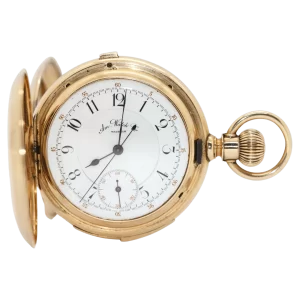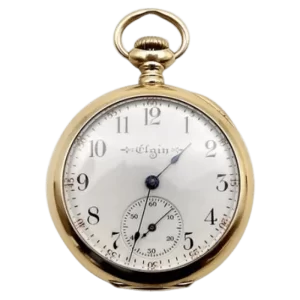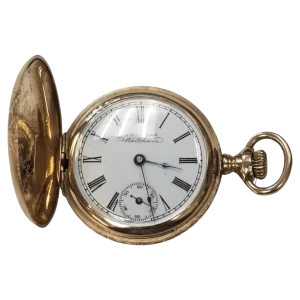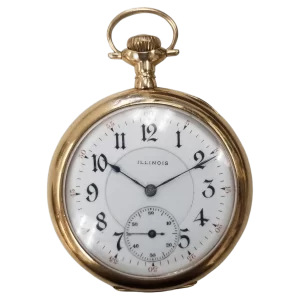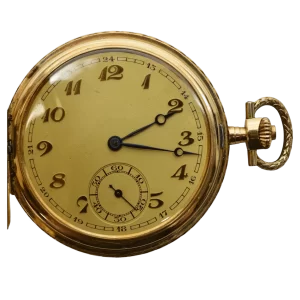Most of the information crucial to identifying a particular pocket watch is inscribed on the watch movement. Different watches allow you to see the movement in different ways, however, and if you don’t realize how your watch opens up you can damage it.
Pry off – on many watches the back cover simply pries open. Sometimes there is an inner “dust” cover that must also be pried open to expose the movement. Often, you will be able to see a hinge on the back, which indicates that the cover opens this way, but occasionally the cover will just pop off. You can usually pry off the cover with a thumbnail or a dull knife blade, but if you are having difficulty make sure that the cover really does pry off before you break something! Also, if you decide to use something sharp like a razor blade or Swiss army knife, be very careful you don’t slice your thumb in the process. Also, care should be taken not to scratch the case. If the cover is meant to be pried off, there will often be a small indentation or “lip” where the blade or thumbnail can be inserted, and if you can’t find any sign of a lip, it may not be a pry off cover. . .
Screw off – Surprise! Some back covers simply screw off, a fact I learned after unsuccessfully trying to pry off the back cover on one of my first watches. If you can’t pry the cover off, try unscrewing it in a counter-clockwise direction. Just be careful you don’t grip the front of the watch so tightly that you end up breaking the crystal in the process. If you have any doubt whether a cover is pry off or screw off, by the way, it is always safer to try screwing it off first. You’re less likely to damage a pry off cover by trying to unscrew it than you are to damage a screw off cover by trying to pry it off.
Swing Out — Some watches don’t actually have a back cover, or else the back cover only exposes the inner dust cover and not the movement. These are usually swing out cases that open from the front. To open a swing out case, you first need to open the front bezel [it’s usually hinged and pries off or else needs to be unscrewed]. If it’s a stem wind watch, you will then probably need to carefully pull on the winding stem until you hear a soft click. The movement should then swing out from the bottom, while remaining attached to the case via a hinge at the top. Care should be taken to not pull too hard, since you don’t want to actually
Guide to Pocket Watches pull the stem right out of the case. And if the stem doesn’t pull out with gentle pressure, make sure that the watch isn’t really in a pry off or screw off case before pulling any harder.
If it’s a key wind watch, instead of pulling on the stem you will probably need to press in a tiny catch at the base of the dial near the 6. This can be a bit of a delicate procedure, and if you have any doubts about whether this is really a swing out case or not your best bet is to bring it to somebody a bit more knowledgeable.





